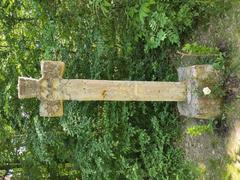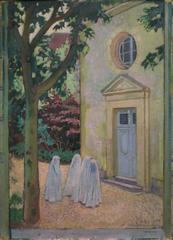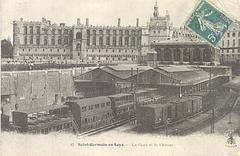Porte de Chambourcy: Visiting Hours, Tickets, and a Comprehensive Guide to Saint-Germain-en-Laye Historical Sites
Date: 14/06/2025
Introduction
Porte de Chambourcy, set between the towns of Chambourcy and Saint-Germain-en-Laye, is a remarkable symbol of France’s royal heritage and its evolving urban landscape. Built in the 18th century as a gateway to the royal hunting grounds of the Château de Saint-Germain-en-Laye, this historic gate once managed access to exclusive forests reserved for French monarchs. Today, it stands as a protected cultural landmark, seamlessly integrated into the vibrant life of the Yvelines region (POP Culture Gouv; Saint-Germain-en-Laye Official; Monumentum).
This guide provides a detailed exploration of Porte de Chambourcy’s history, architectural features, visiting logistics, and its connection to nearby attractions. Whether you’re a history enthusiast, a nature lover, or a traveler seeking an authentic experience in the Île-de-France, this article will help you make the most of your visit.
Table of Contents
- Historical Overview
- Architectural and Symbolic Importance
- Role in Royal and Local History
- Visiting Information
- Accessibility
- Nearby Attractions
- Events and Community Life
- Practical Visitor Tips
- Frequently Asked Questions (FAQ)
- Conclusion
- Sources
Historical Overview
Porte de Chambourcy originated in the 18th century, during a period when the French monarchy sought to manage and protect the royal forests enveloping the Château de Saint-Germain-en-Laye. The gate was part of a broader network of enclosures designed to safeguard game and control access to the king’s hunting grounds. Its robust construction and strategic placement underscore both its practical and symbolic roles as a boundary marker between royal privilege and the surrounding countryside (POP Culture Gouv; Monumentum).
The surrounding Forêt de Saint-Germain-en-Laye, a remnant of ancient woodlands, was carefully curated by royal decree for leisure and sport. Over centuries, the forest and its gates have witnessed shifts in land management, urban growth, and the democratization of public spaces following the French Revolution.
Architectural and Symbolic Importance
Porte de Chambourcy exemplifies the utilitarian yet dignified style of 18th-century French architecture. With its solid masonry, symmetrical design, and measured ornamentation, the gate was crafted to be both functional and a symbol of authority. Set at the transition between forest and plain, it delineates the boundary of what was once an exclusive royal domain (Wikipatrimoine).
Its survival through centuries of political change and urban transformation attests to its enduring significance. Designated a Monument Historique in 1943, it remains a testament to France’s commitment to preserving its architectural and cultural heritage.
Role in Royal and Local History
Royal Hunting and Forest Management
The gate played a pivotal role in royal hunting expeditions, facilitating controlled access for the king and his court. The network of gates and enclosures reflected the interconnectedness of royal lands, including the neighboring forests of Marly and Saint-Germain (Saint-Germain-en-Laye Official).
Urban and Territorial Development
As royal authority diminished, the gate’s function shifted from exclusive access to a symbol of local heritage. The development of Chambourcy and Saint-Germain-en-Laye was shaped by these historic boundaries, influencing patterns of settlement and land use.
Modern Preservation
Today, the Porte de Chambourcy is maintained under state protection, reflecting ongoing efforts to balance heritage conservation with the needs of a growing urban population (POP Culture Gouv).
Visiting Information
Location and Access
- Address: 4 Chemin de la Forêt, 78240 Chambourcy
- Access: Easily reached by car via the N184 or D113 and by public transport, including RER A to Saint-Germain-en-Laye and local bus routes (Monumentum; Mappy).
Visiting Hours and Tickets
- Porte de Chambourcy: Open to the public year-round, with no entrance fees or ticket requirements.
- Nearby Museums and Sites: Hours and ticket prices vary. For example, the Musée d’Archéologie Nationale is open Tuesday to Sunday, 10:00 AM to 6:00 PM (last entry at 5:15 PM), with tickets generally ranging from €5–12 (France-Voyage).
Guided Tours and Activities
- Guided walks and cultural events are frequently organized by the city, especially during annual heritage celebrations. These offer insights into the history and ecology of the area (Saint-Germain-en-Laye Official).
Accessibility
- Terrain: The site is outdoors and may have uneven ground; accessible in most weather conditions.
- Mobility: Most new developments and public areas are designed to accommodate visitors with disabilities, but those with mobility concerns should confirm details with local authorities before visiting.
- Parking: Ample parking is available nearby, both free and paid.
Nearby Attractions
- Château de Saint-Germain-en-Laye: Former royal palace and National Archaeological Museum, with Renaissance architecture and panoramic gardens (France-Voyage).
- Forêt de Saint-Germain-en-Laye: 3,500 hectares of woodland for hiking, cycling, and nature appreciation.
- Désert de Retz: An 18th-century garden landscape featuring architectural follies.
- Château de Monte-Cristo: Alexandre Dumas’s residence, a showcase of 19th-century romanticism.
Events and Community Life
Saint-Germain-en-Laye hosts cultural events year-round, including concerts, art exhibitions, and the historic Fête des Loges funfair. Local markets and food festivals showcase regional cuisine, and guided tours are available through the Tourist Office (Wanderlog).
Practical Visitor Tips
- Best Time to Visit: Spring and autumn for pleasant weather and colorful forest scenery (Triplyzer).
- What to Bring: Comfortable walking shoes, water, and weather-appropriate clothing.
- Language: French is the primary language; English is widely spoken in tourist areas.
- Payment: Euros are accepted everywhere; cards are widely used.
- Safety: The area is considered safe; standard precautions apply.
Frequently Asked Questions (FAQ)
Q: Are tickets required to visit Porte de Chambourcy?
A: No, the site is open to the public free of charge.
Q: What are the best times to visit?
A: Year-round access, but spring and autumn offer the most pleasant conditions.
Q: Is the site wheelchair accessible?
A: Many new developments and public spaces are accessible; check local resources for details.
Q: Are guided tours available?
A: Yes, particularly during heritage festivals and through local tourism offices.
Q: What else can I visit nearby?
A: Château de Saint-Germain-en-Laye, Forêt de Saint-Germain-en-Laye, and Désert de Retz are all within easy reach.
Conclusion
Porte de Chambourcy serves as both a physical and symbolic gateway to the rich cultural landscape of Saint-Germain-en-Laye and the broader Yvelines region. Its significance extends from royal history to modern urban living, making it an essential stop for those interested in French heritage. With year-round free access and proximity to major cultural sites, it offers a seamless blend of history, nature, and contemporary life.
For in-depth guides, route planning, and event updates, consult the Saint Germain Boucles de Seine Tourism Office and related travel platforms. Download the Audiala app for curated itineraries and exclusive local tips.
Sources and Further Information
- POP Culture Gouv, 1943, French Ministry of Culture
- Monumentum, Porte de Chambourcy Monument Historique
- Saint-Germain-en-Laye Official Website, Cultural Walks and Heritage
- Saint Germain Boucles de Seine Tourism Office
- France-Voyage, Tourism in Saint-Germain-en-Laye
- SeLogerNeuf, Real Estate Developments in Chambourcy
- Mappy, Location Information
- Triplyzer, Things to Do in Saint-Germain-en-Laye
- Wanderlog, Top Attractions in Saint-Germain-en-Laye




